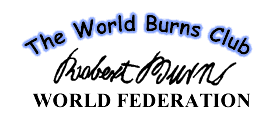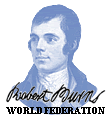|
|
|
|
|
|
|
|
|
|
FARMING AT THE TIME OF ROBERT BURNS
Robert Burns lived from 1759 to 1796 and, in that time, he was a
farmer as well as a poet. He lived and worked on a number of farms
from Mount Oliphant, to Lochlea, to Mossgiel and finally to Ellisland,
all of which are to be found in Ayrshire and Dumfriesshire.
|
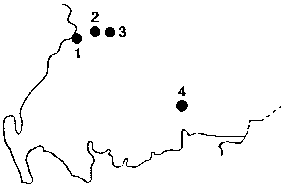 |
|
|
|
|
1
MOUNT OLIPHANT
2 LOCHLEA
3 MOSSGIEL
4 ELLISLAND |
|
He first
thought of a number of his works as situations arose when he was
ploughing his fields. Two examples are "To a Mouse", when
he nearly killed it with his plough and, "To a Mountain Daisy",
which he had just ploughed under.
CHANGES
ON THE LAND
This
was a period of great change on the land throughout Lowland Scotland
(the Highlands did not change at the same pace). The whole system
of farming the land, and land tenure, was altered completely.
This period of change has been given a number of titles including:-
THE AGRICULTURAL REVOLUTION
THE IMPROVEMENT
THE ENCLOSURES
All three titles are correct since there was a revolution in the
way the land was farmed, the land was improved, and the open field
system was replaced by fields enclosed by hedgerows or dykes.
Before we look at the changes (Improvements) which took place we
must first find out what the land was"like beforehand.
FARMING
BEFORE THE IMPROVEMENTS
Throughout
Scotland the land was farmed by a method known as the run-rig system.
There were no large farms as we know them today, instead the land
was divided into numerous, narrow strips of land. These strips consisted
of ridges of cultivated land ? the rigs ? separated from one another
by quite deep ditches. These rigs were, on average, 30 feet broad.
The hollows acted as shallow drains for the rainwater, but most
of them were covered in reeds, broom and marsh plants.
The farmers rented the land from the local landowner and usually
paid him in kind. They lived in small clusters of houses and, each
day, went forth to farm their rigs and tend to their animals. Most
of them rented a number of rigs, but it was unusual for a farmer
to have two or more rigs alongside each other. These strips were
curved into a sort of S shape because of the need for turning space
for the teams of oxen pulling the heavy, wooden, "Old Scots
Plough". The best land (known as the Infield) was always kept
under crop. It was never rested and, on most rigs, the same crop
was grown year after year.
|
|
|
|
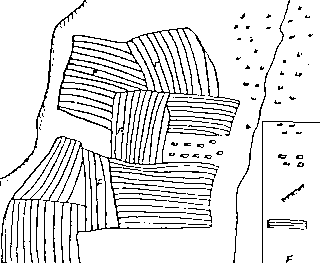 |
|
|
|
|
|
Common
Grazing
|
|
|
|
|
|
|
Marshland
Township
Steep Slopes
Rigs
One Farmer's ' Field |
|
Some
of the poorer township land (Outfield) was either cropped once in
a while or left as pasture.
Nearly every farmer kept a few animals and grazed them on the common
grazing land, which was shared by all the villagers.
Not all the land was arranged in rigs. The people were not able
to drain the land so there was a great deal of marshland. In fact,
the flat land with the deepest and richest soil, close to the river
banks, was flooded nearly every year and couldn't be used for farming.
These marshlands were home to numerous insects, including the mosquito,
which spread diseases amongst the country folk. But they were also
home to wild fowl which were much sought after as a source of fresh
meat. They also provided the villagers with peat for their fires,
sods for roofs, reeds and broom to thatch their roofs. In brief,
the landscape would be a completely alien one to anyone from our
time. At this time Scotland also gained a reputation of being the
home of many inventors and their inventions.
Eventually, the ever increasing population forced many people to
emigrate or seek work in the towns. Others just wanted to try their
luck elsewhere. In the Highlands and Islands the story was different.
Much of the land was too poor to improve so the landowners had to
think of something else, and in many cases this was the introduction
of large sheep farms.
(Try to find out what is meant by the term
"THE HIGHLAND CLEARANCES")
SOME NOTABLE IMPROVERS
Earl of Eglinton in Ayrshire
John Cockburn of Ormiston, in East Lothian
Sir Archibald Grant of Monymusk, in Aberdeenshire
John, Earl of Stair on his lands in West Lothian and Wigtownshire
Craik of Arbigland who introduced the new methods to Galloway Henrietta
Mordaunt, in Morayshire
Mr Callander of Craigforth, for changes around Stirling Brigadier?General
Dirom, in Dumfriesshire.
WHAT
ARE FARMS LIKE TODAY?
The Improvements first started in the 1700's have continued to take
place and, in the last 50 years, the arrival of the internal combustion
engine has seen the replacement of the horse by the tractor. The
introduction of very large combine harvesters has resulted in many
farmers cutting down hedgerows to make fewer, but larger fields.
|
|
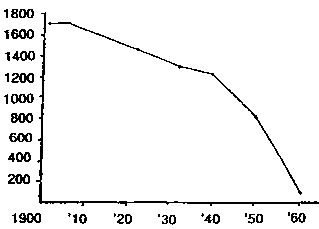 |
|
|
|
|
|
|
Approximate
Number of Horses working on farms in ayrshire |
|
The land is once more undergoing change, but whether this could be
called an improvement remains to be seen. The efforts spent on making
these improvements was enormous and took many generations. The map
overleaf shows the same area as the map in the old farming section,
but this time a number of rigs have been changed to the new system
and part of the marshland has been drained. In the end, more land
was farmed than ever before, the farms were larger and the yields
increased. Farmers were now able to grow more than they needed so
they were able to sell their produce. All the coming and going of
fertiliser and harvested crops meant that the road system had to be
improved
|
|
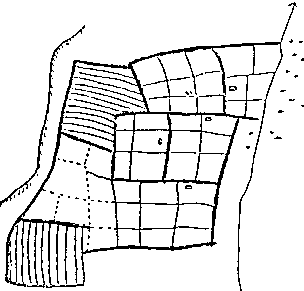 |
|
Marshland
Farmhouse
Riggs
Steep Slope
Boundary between the new farms
New Fields
New fields being laid out
|
|
|
dramatically. Before the Improvements there were very few roads,
only poor tracks. Many people were employed to build and maintain
new roads. As the demand for roads increased quite a few Scots made
their fame and fortune from this, two notable examples being Thomas
Telford and John MacAdam. The increased interest in the land also
resulted in a rush of new inventions to help the farmer, e.g. lighter
ploughs, reapers and threshers.
The lighter plough caused another change - the oxen were replaced
by sturdy horses. Horses were a bonus as they were easier to handle
and could do the work a lot faster than the oxen ever could.
WHAT ABOUT THE VILLAGES AND THE PEOPLE?
The majority of the old villages 'ferm touns' (or farming townships)
were demolished. Most of the people no longer worked their own plot
of land. They were displaced by the landowner, who decided who would
become the new tenant farmers. However, at the beginning, most of
the displaced people did not leave the land. Instead, they became
farm labourers or farm servants. Others became tradesmen as the
demand for all sorts of things increased, e.g. weavers, stone masons,
wheelwrights, millwrights, slaters, saddlers and farriers.
|
|
 |
 |
 |
 |
 |
 |
 |
 |
 |
 |






